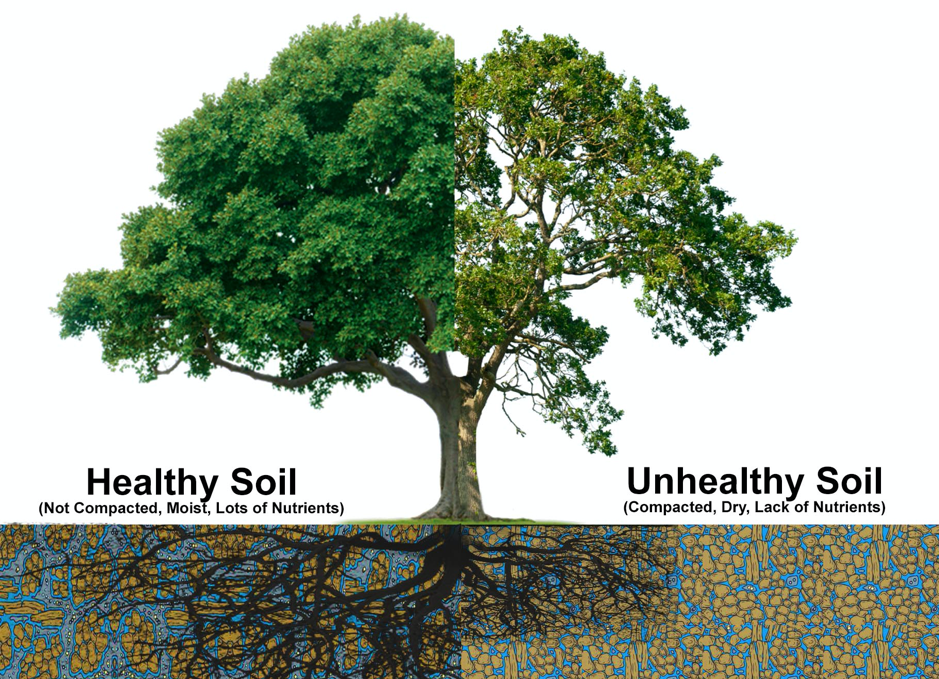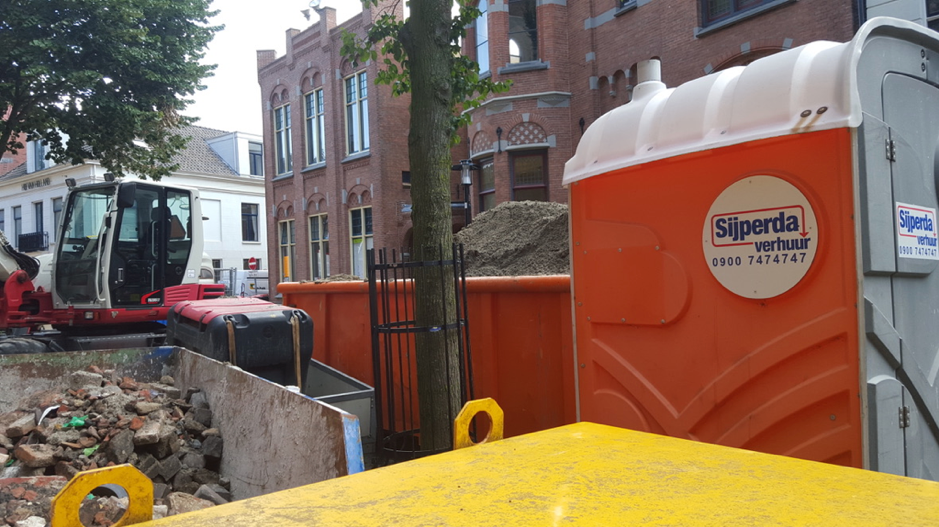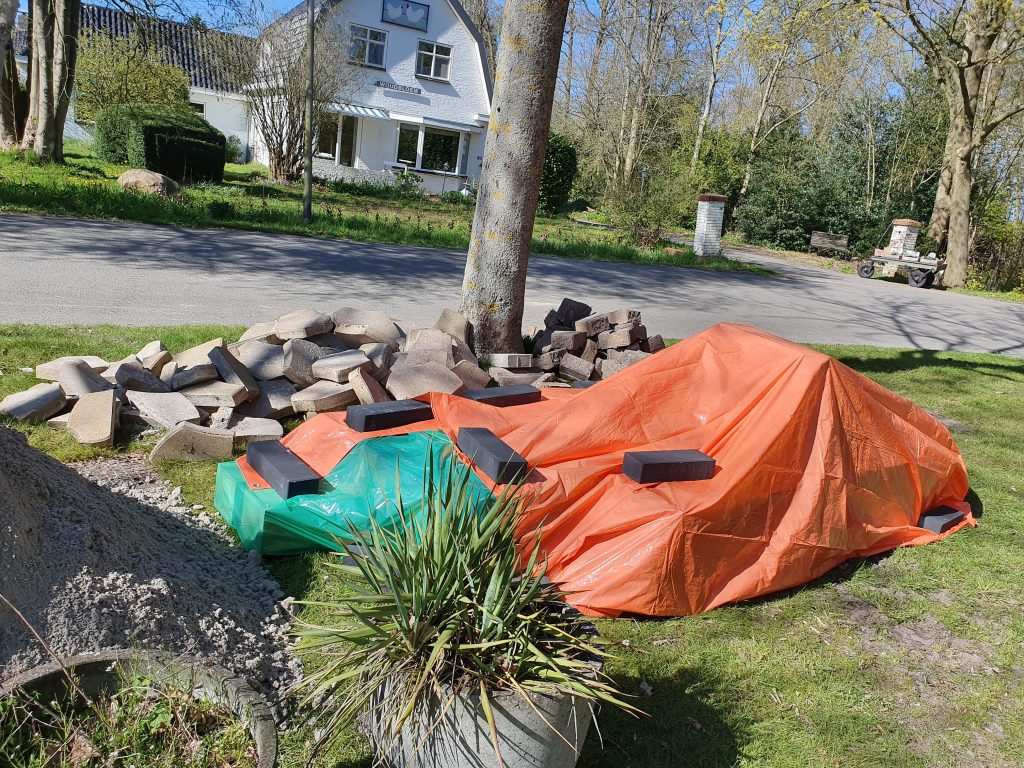Engelse vertaling en afbeeldingen zie hieronder.
Bij civiele geschillen over schade aan gemeentebomen laat de stad tegenwoorden de bewoners het onderling uitvechten. Het zal u niets verbazen wie er wint: degenen die de bomen beschadigen.
De beste manier om schade aan een boom tijdens de bouw tot een minimum te beperken, is door niets te doen rond, in of bovenop het wortelstelsel van een boom. Bouw daarom een stevige omheining bij de buitenste druiplijn van de boom en laat binnen dit gebied geen activiteiten toe. Activiteiten die hieronder vallen zijn onder meer
- het verlagen van de helling
- het toevoegen van grond
- het graven van sleuven
- het parkeren of bedienen van machines in het gebied
- het opslaan van voorraden, grond of graafmateriaal.
(Bron: Iowa State University Extension and Outreach, Urban Forestry, https://hortnews.extension.iastate.edu/faq/what-effects-will-construction-activities-have-nearby-trees)
Steeds vaker zien we in Groningen een gebrek aan zorg en kennis over het werken rond gemeentebomen. Maar ook omwonenden die het publieke groen en dus ook de ruimte onder het bladerdak van een stadsboom als persoonlijke ruimte beschouwen en het gebruiken als vuilstortplaats voor afval, bouwmaterialen, als opslagruimte voor zware machines of als parkeerplaats voor auto’s.
Boomwachters Groningen krijgt, als ze schade aan gemeentebomen, wortels en grond via de normale klachtenroute op de website van de gemeente signaleren, doorgaans geen reactie. Maar als we de betreffende ambtenaar persoonlijk mailen, krijgen we vaak binnen een paar dagen een reactie.
Volgens het beleid van de stad (APVG) moet de groenafdeling van de gemeente na een melding de situatie onderzoeken. Als het boomkroongebied van stadsbomen wordt overladen door bouwmaterialen of andere belemmeringen, waarvoor geen vergunning is afgegeven, dan moet de bewoner of andere verantwoordelijke worden gevraagd om de materialen onmiddellijk te verwijderen. Ambtenaren kunnen bij dergelijke overtredingen ook boetes opleggen. Helaas wordt bovenstaande regel nauwelijks gehandhaafd en laat de ambtenaar zijn oor vaak hangen naar de behoeften van degene die de overtreding begaat. Hierdoor ontstaat blijvende schade door zware machines of bouwmaterialen die dagen of zelfs weken onder een boom blijven staan.

Bodemverdichting
Wanneer zware voorwerpen onder een boom worden geplaatst, kan de grond snel verdichten, met als gevolg dat water, voedingsstoffen en zuurstof niet worden doorgelaten kunnen worden waardoor uiteindelijk de wortels afsterven. Soms is de schade van zo’n verdichting al na maanden, maar meestal pas na jaren waarneembaar. Omdat daardoor de boom dus ook pas na vele jaren verslechtert zien bewoners niet de relatie tussen het verdichten van de bodem en de slechte conditie van het bladerdak. Elke boom-, grond-, wortel- en mycorrhiza-expert weet wel beter. Gemeenten, ook die van ons, hebben codes en best practices die vereisen dat boomstroken worden beschermd tijdens bouwprojecten en nooit mogen worden gebruikt als opslag- of stortplaats. Toch worden deze best practices zelden opgevolgd en leiden meldingen van overlast bij bomen bij de gemeente zelden tot onmiddellijke verwijdering van de zware materialen laat staan tot boetes.
Het verdichten van de grond kan binnen enkele uren plaatsvinden. In feite zouden bepaalde activiteiten nooit onder het bladerdak van een boom mogen plaatsvinden. Volgens het Oregon State Extension Urban Forestry Program mogen onderstaande zaken nooit voorkomen onder het bladerdak van een boom:
- Neerzetten van bouwmaterialen of sloopafval.
- Parkeren van voertuigen of apparatuur.
- Opstapelen van grond, zand en/of mulch.
- Graven van sleuven voor installatie of reparatie van nutsvoorzieningen, of voor installatie van irrigatiesystemen.
- Veranderen van bodemkwaliteit door snijden of opvullen.
- Beschadigen van wortels door sorteren, scheuren of rooien.
- Bodemverdichting met materieel, voertuigen, materiaalopslag en/of voetverkeer.
- Vervuilen van grond door schoonmaken van apparatuur (vooral beton) en voertuigonderhoud.
- Aanleggen van ondoordringbare parkeerplaatsen, opritten en voetpaden.
- Iets aan bomen bevestigen met spijkers, schroeven en/of spijkers.
- Het verwonden of breken van boomstammen of takken door contact met voertuigen en zwaar materieel.
- Verwonden van stammen met onkruidtrimmers en grasmaaiers.
- Verwonden door brand of overmatige hitte.
(Bron: Boombescherming op bouw- en ontwikkelingslocaties: A Best Management Practices Guidebook for the Pacific Northwest, 2009, p. 4)
Hier zijn andere manieren om bodemverdichting onder een volwassen of jonge boom te voorkomen volgens de bekende BomenDoctor:
Hoe voorkom je bodemverdichting?
- Rij en parkeer NIET op de wortelzone van de boom. Kijk op de schets en respecteer de totale boombeschermingszone.
- Zet bouwwerken niet binnen de wortelzone van de boom (zie onderstaande totale kroonbeschermingszone) waardoor het onmogelijk wordt om met machines op deze plaats te komen. Maak voor de start van de woning duidelijke afspraken met de aannemer dat deze zone niet kan worden betreden.
- Laat ook geen afval, grond, voorraad van materiaal etc. toe in deze boombeschermingszone.
- Indien er toch kranen moeten passeren, kies dan voor een kraan met rupsbanden. Maar deze mogen niet manoeuvreren in de wortelzone en er moeten rijplaten gelegd worden. Dit zijn sterke platen die de druk van de machine verdelen over de grond zodat de impact op de grond lager is.
- Gebruik zo weinig mogelijk machines in je tuin, ook bij de tuinaanleg. Indien dit toch nodig is, gebruik rijplaten.
(“Wat zijn de gevolgen van bodemverdichting op je bomen en planten?” 7-7-2021, geciteerd op 23-7-2-21, https://deboomdokter.be/blog/bodem /wat-zijn-de-gevolgen-van-bodemverdichting-op-je-bomen-en-planten/).
Ervaring boomschadegeschil in Haren, juli 2021
Deze week, na een maand grote stapels zware bakstenen, zandzakken, verspreid zand, potten en andere ongebruikte troep onder twee gemeentebomen te hebben gezien, bracht ondergetekende een vriendelijk bezoek aan haar buurman met een informatieve flyer over de gevaren voor bomen en grond wanneer zware materialen geplaatst worden op wortelstructuren. Ondergetekende deed ook een vriendelijk verzoek om het materiaal te verwijderen. De buurman nam de flyer in ontvangst en luisterde maar deed uiteindelijk niets en de materialen bleven nog enkele weken liggen en erger nog er kwam nog meer materiaal bij. Hierop nam ondergetekende actie en maakte de ruimte onder de boom vrij van bouwafval. Hierop reageerde de buurman met verbaal en fysiek geweld waardoor ondergetekende zich genoodzaakt voelde de politie te bellen.
The Wild Wild West of Groningen’s Urban Green Spaces
In civil disputes about damage to municipal trees, the city lets residents fight it out themselves.
Guess who wins? (spoiler alert) – aniti-tree bullies and urban green colonizers
Kristin McGee, July 23, 2021
“The best way to minimize damage to a tree during construction is to do nothing around, in, or on top of a tree’s root system. Construct a sturdy fence at least at the outer dripline of the tree and allow zero activity within this area. Prohibited activities inside the dripline of the tree include lowering the grade, adding soil, trenching, parking or operating machinery in the area, and storing supplies, soil, or excavation materials.” (Iowa State University Extension and Outreach, Urban Forestry)
Increasingly in Groningen we see a lack of care and knowledge about working around municipal trees, including by local residents who view grassy plots under a city tree’s canopy as personal space. Here tree strips are misused as a dumping ground for garbage, building materials, as storage space for heavy machinery, or as parking spaces for personal automobiles.
In the instances when we (the Boomwachters) signal this damage to municipal trees, roots and soil via the normal complaint route on the gemeente’s website, we generally get no reaction. Yet when we mail one of the tree bureaucrat’s personally, we often get a response within a few days. According to the city’s policies (APVG), the gemeente’s green division should investigate the situation and if city’s tree canopy area is deluged by building materials or other hinderances, and without a permit, a resident should be asked to immediately remove such materials. City workers can also fine such infringements. However what rather happens is that the green bureaucrat simply listens to the needs and intended plans of such a (reckless) resident and allows them to continue mistreating city trees, sometimes allowing heavy machinery or building materials to remain for days and even weeks under a tree’s canopy. This isn’t surprising since the city too often parks vehicles, equipment, and bricks on the fragile soil under a tree’s crown.


Soil compaction
When heavy items are placed under a tree, the soil can quickly compact, blocking water, nutrients, and oxygen and eventually killing the roots. Usually the damage from such compaction is not discernable for months, but rather in years and so residents and others look up at the tree and when seeing green leaves they say – “ah stop worrying – het valt mee (it is fine)”. No actually it isn’t fine as any tree, soil, root, and mycorrhizal expert will tell you. Municipalities, including our own, have codes and best practices in place which require that tree strips are protected during building projects and should never be used as storage sties or dumping grounds. Yet rarely are these best practices followed and our alerting the municipality to tree negligence cases rarely results in immediate removal or fines.

Image of soil and roots underground tree with healthy and unhealthy soil (source, RTEC Tree Care)
Compacting soil can happen in a matter of hours. In fact certain activities should ideally never happen under a tree’s canopy. According to the Oregon State Extension Urban Forestry Program, these things should never occur under a tree’s canopy:
• Stockpiling construction materials or demolition debris.
• Parking vehicle or equipment.
• Piling soil, sand, and/or mulch.
• Trenching for utilities installation or repair, or for irrigation system installation.
• Changing soil grade by cutting or filling.
• Damaging roots by grading, tearing, or grubbing.
• Compacting soil with equipment, vehicles, material storage, and/or foot traffic.
• Contaminating soil from washing out equipment (especially concrete) and vehicle maintenance.
• Installing impervious parking lots, driveways, and walkways.
• Attaching anything to trees using nails, screws, and/or spikes.
• Wounding or break tree trunks or branches through contact with vehicles and heavy equipment.
• Wounding trunks with string weed trimmers and lawn mowers.
• Causing injury by fire or excessive heat
(Tree Protection on Construction and Development sites: A Best Management Practices Guidebook for the Pacific Northwest, 2009, p. 4)
A tree damage dispute in Haren, July 2021
This week, after a month of seeing large stacks of heavy bricks, sand bags, disperced sand, pots and other unused junk under two municipal trees, I made a friendly visit to this neighbor with an informative flyer about the dangers for trees and soil when leaving such materials over root structures. I also made a gentle request that this material be removed. The neighbor took my little flyer and listened but eventually did nothing and the materials remained there for several more weeks.


Then a week ago, a new pile of bricks and sand were dumped directly at the base of an ash tree which was recently heavily pruned by the city and thus was already recovering from the loss of part of its crown. I waited a week and then decided to remove this material myself since it was clearly unwanted as it was dumped in no particular way with piles of sand thrown out over the grass under the tree. Mid-way through, I was accosted by the owner of the house near the tree. He demanded I put his bricks back, went into my car taking out the bricks and throwing them again directly at the base of the tree (why not on his own lawn?). Throughout, he pushed me several times despite my request that he desist. I even requested that at least he move the bricks farther away from the tree trunk base. He did not.
I eventually called the police and rather than even ask me what had happened and why I had called (the neighbor was physically abusive and bullying), the police went directly to the tree bully, heard his story, took his side, and simply told me I shouldn’t have called and there was nothing they could do – it was a matter for the municipality. My explanations that a requst to the municiple’s general complaint portal received no response and after much debate, condensation, incriminating questions about where I was from, and demands for my ID, the police left and the bricks remained where they were. Although later the bully decided to make a joke of all this and place his bricks in a heart shape around the tree. If he could take time to do this, then why not just move them away from the tree to his own large property of freshly laid, yet treeless lawn (a veritible ecological deadzone).

Then when conveying this story to the municipality (with digitally dated photographs), rather than request that this man remove this building materials immediately, they simply ask him what his plans are. He says he intends to leave it there for still another week, and guess what? The city worker says its fine. They city’s management has policies in place about what is allowed (this dumping of building materials is not allowed), but apparently here as a local resident (and bully), you don’t have to follow such codes, and you can do whatever you want for as long a you please, even if you severly compact the soil under city trees. This is quintesential laissez faire (non) governing with regards to urban green protection and we feel this is gross negligence on the part of the municipality.
Negligence by the city and the encroachment of public green zones
This kind of inactivity by the city gives a clear signal to residents that they can vandalize our green spaces and trees with impunity and increasingly they do just that. Tree vandalism and illegal removals are on the rise, and increasingly they are not fined and so damage and removal of trees is allowed with no consequence for the vandalizers. As boomwachters and as concerned citizens for our urban forest, we certainly don’t deserve to be intimidated, dismissed or assaulted for simply protecting what the municipality should have already protected. We continue to insist that due diligence must be executed by the city’s green bureaucrats. But time and again, the gemeente lacks real leadership, vision, and expertise and bureacrats are more than willing to allow the demise of our urban trees for the personal use of local residents who should be happy they have these life giving, cooling, pollution filtrating, bird hosting entities in their neighborhoods. And in a municipality with one of the lowest tree cover rates in the country (12%), we can’t afford to continue colonizing urban green spaces and destroying trees through illegal felling or through root destruction with garbage and building materials. Since 2010, we have lost 30% of our urban trees, and it is in part because of declining tree health from gross long-term negligence and compaction of soil by both city workers and local residents.
The boomwachters continues to communicate with the city about these problems and is hopeful for a dramatic change in the procedures for protecting our urban forest.
If you are upset about how the city handles such complaints, please send them (info@gemeentegroningen.nl) a letter (Gemeente Groningen, postbus 30026, 9700 RM Groningen) or respond on their website (https://gemeente.groningen.nl/vraag-stellen) and feel free to cc the boomwachters at info@boomwachtersgroningen.nl.
Sources and further information:
Poster – Werken Rond Bomen: https://www.treevision.nl/files/Media/PDF%20bestanden/bomenposter-pdf.pdf
“Wat zijn de gevolgen van bodemverdichting op je bomen en planten? De Boomdokter.” 2021. https://deboomdokter.be/blog/bodem/wat-zijn-de-gevolgen-van-bodemverdichting-op-je-bomen-en-planten/
“A Guide to Preserving Trees in Development Projects.” https://hortnews.extension.iastate.edu/faq/what-effects-will-construction-activities-have-nearby-trees
Puis Floris. 2021. Webinar: “Beschermen van bomen in projecten.” https://www.youtube.com/watch?v=Cf9r8rhi4c8
